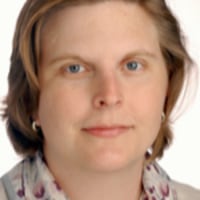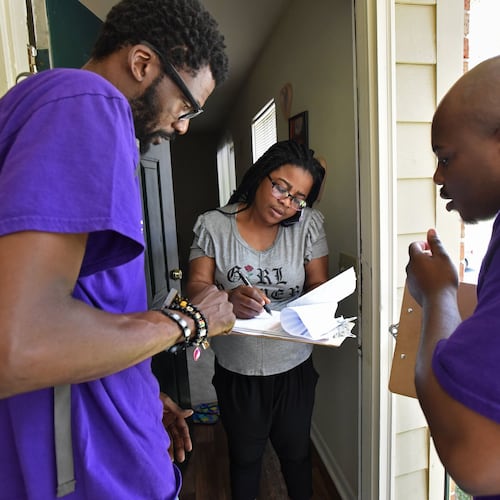There is no doctor in all of Webster County, and the pharmacist there has seen the wreckage.
One woman’s first pregnancy visit was her trip to give birth. One patient has walked miles to Columbus for appointments. Some patients just don’t see a doctor.
“They have heart attacks and they die,” said Nikki Bryant, the owner of the county’s lone pharmacy, lodged inside her father’s grocery store.
Georgia’s Legislature is once again brainstorming legislation to address the state’s rural health care crisis. Sixty-four of 159 counties have no pediatrician; 79 have no obstetrician/gynecologist; and nine, like Webster, simply have no doctor. That makes Georgia worse than the national average for needy areas short of primary health care providers, according to federal data assembled by the Kaiser Family Foundation. Health outcomes for Georgia patients lag accordingly, with the state ranked among the worst 10 states for most measures.
When lawmakers return to their deliberations at the state Capitol in January, amid Fulton County's 4,500 doctors, vast swaths of their constituents back home will be living in a different world. The legislators have repeatedly created health care study committees and passed some legislation. But a major fix remains distant.
Dr. Vikas Saini, the president of the Massachusetts-based Lown Institute, which advocates for health of communities, calls the rural doctor shortage a major issue that reaches beyond Georgia, especially since rural residents tend to need more health care than urban ones.
“That is a national problem; there really is major disparity in rural settings in terms of physicians,” he said. “The doctor shortage is the tip of a broader iceberg. What we really need is more significant attention and investment. But it can’t be piecemeal. It has to be a comprehensive and integrated plan, which is not something we do very well.”
And it matters to everyone, including metro Atlanta.
“You don’t see it immediately or directly in the cities, but people who don’t have good access to care, when they get there, they’re sicker, they come there later and their use of resources is higher,” Saini said. Plus, “It’s not either/or. Many of the same solutions that would make a difference in rural areas would make a difference for people who are struggling in urban areas.”
Distance and poverty
The doctor void disrupts Bryant’s own care for her patients. She’ll come across medication regimens that need updating or a physician’s review, to no avail.
Webster County is small, and when a well-off resident needs to visit a doctor, it’s no problem to drive one county over or even go the 45 miles to Columbus. If they’re poor, it is a problem.
“At least once or twice a week there’ll be someone I’ll call and say, ‘You’ve got to get to the doctor’s office,’ ” Bryant said, “and they say, ‘Well I ain’t got a ride.’”
Gas costs money, and 21 percent of Webster County residents live in poverty. When someone with a working car gives a long ride, he may expect payment. The U.S. Census Bureau estimates that perhaps 9 percent of the county’s households have no car.
The poverty that doctors are dealing with in their patients is daunting.
Cary Moore, an insurance agent for older low-income clients, drives between their homes all day.
“I mean, I have seen them with lawn chairs for furniture, sleeping on a mattress put on the floor with no frame,” he said. About once a month he’ll visit someone who has plastic or cardboard instead of windows, and more often, people with no teeth or no car. Some are taking care of grandchildren. “That’s just how it is,” he said.
“A lot of them may have worked as domestics or farm labor for a person who didn’t take out taxes,” he said, which they only realize too late when they retire and find themselves in trouble trying to get Medicare or Social Security income. “Here, say, the closest doctor’s 20 miles away, and it’s hard for them to get their friends to drive them to the doctor and then sit there two hours. It’s gonna tie up half a day.”
Moore signs eligible people up for dual enrollment in Medicaid and Medicare. He’s always on the lookout for plans that include transportation to doctor visits.
Follow the money
Much is made of rural population declines and professionals such as doctors leaving with everyone else. But according to the Census Bureau, Webster and Stewart counties’ populations have both grown a bit since 2000.
There are other factors at work.
For starters, money.
Rural counties have a lot of patients on Medicare and Medicaid, as well as patients without insurance at all. When doctors see patients on Medicare or Medicaid, they’re most likely losing money, being reimbursed below cost.
Income matters, said Daniel Singleton, a doctor in Buena Vista whose family’s ties to Marion County go back to the Creek Indian expulsion.
If rural doctors were paid in full, you’d have more rural doctors, he said.
Raising the government's reimbursements for care to 100 cents on the dollar, so that doctors aren't losing money when they work with Medicare and Medicaid patients, isn't in the cards, said state Rep. Terry England, a Republican from Auburn. He's the chairman of Georgia's powerful House Appropriations Committee and is leading a two-year task force on rural development.
“Where are you going to find the money?” England said. “We’re just not able to. You’re talking about several hundreds of million dollars more. We have to balance a budget every year.”
The same goes for Medicaid expansion, he said. Georgia’s GOP-dominated Legislature decided not to expand Medicaid under the Affordable Care Act, saying the state could not afford the long-term cost. That has left adults who earn less than the poverty level uninsured. But it doesn’t keep them from showing up for care in hospitals and doctors’ offices, with no way to pay.
Some legislators, including England, have said they might be willing to look at some sort of a waiver that expands coverage but includes a work requirement, though they still oppose an outright Medicaid expansion.
Walking home from Columbus
There is a state Department of Public Health clinic in Webster County, but officials cautioned it’s not for people to show up like at their doctor’s office when they’re sick or have a broken bone. “Public health is more a preventive type of thing,” for example, to stem the spread of sexually transmitted diseases, spokeswoman Pam Kirkland said.
A sparse population may make it harder to treat people, but they shouldn’t be left to founder, Bryant said.
“Even if there’s three people, they still need health care,” Bryant said. “How do you put a value on life? Is my life not as valuable just because I don’t live in Atlanta?”
Bryant has faced that head-on in her own business: She delivers. Once she started, her business ballooned. She now has a full-time driver who covers eight counties. In addition to paying him, the gas for his vehicle costs $60 a day, “easy,” she said, but she eats the expense and and still makes a living. “We just pray a lot, I guess,” she said.
When patients really need a doctor, they can call an ambulance, though there are only two.
“We have the EMT’s, we call them,” said Marilyn Crimes, the manager of Mom’s Kitchen in Preston, the Webster County seat.
Crimes has a car, but others sometimes tie the ambulances up for things like women going into labor.
And they all have long drives, with hospitals now about 30 to 50 miles away. The small local one, Stewart-Webster Hospital, shut down in 2013.
Jennifer Gardner heads one of the carless households, in an area on the edge of the county called Cusseta. She’s had numerous surgeries, and she and her teenage son use her disability check to get the cheapest rides they can to medical appointments in Columbus. She often sees a nurse practitioner and just calls her doctor.
There’s no question, Gardner said, that the difficulty in getting to medical services has hampered her health. Before Bryant offered to deliver drugs to her part of the county, she would just run out. “I was forgetful,” she said.
Ubers and Lyfts to the doctor can cost up to $30, and they won’t come out to her house for a pickup, only driving the home trip. So sometimes she’ll call a taxi for the first leg, which costs three times as much. At least once, Gardner and her son set out on foot. She thinks they walked about eight miles back from Columbus. “We stopped and leaned on the guardrail,” she recalled. “Someone stopped and picked us up and took us the rest of the way.”
Steps and stops
Just over a decade ago, Webster County had a doctor, at least part of the week, an internist educated in Kazakhstan and at Emory University. He manned a clinic that Stewart-Webster Hospital set up in Preston for a while.
But he left, and the hospital gave up and shut the clinic.
The doctor moved to metro Atlanta and is now practicing in Cobb County.
Singleton, the doctor in Buena Vista, is not surprised.
Money is an issue, but maybe more important is the environment. “This is not the lifestyle that most doctors want,” Singleton said.
“Medicine is an elite profession,” he said. “Unless you’re a country boy from South Georgia, it’s very very difficult to motivate someone to come back and live in a place like this.”
Singleton likens his practice to his service in the Peace Corps: a mission. Not everyone’s on a mission.
“I don’t think working in a rural area is a lost cause,” he said. “You don’t have to be from the community, but you have to want to be connected to the community.”
Dr. Donald Pathman says community culture and welcome mean more to doctors than you might think. Pathman is a professor at the University of North Carolina’s medical school, in family medicine, and he studies rural doctors.
“I have a slide in my PowerPoint that says ‘Doctors are people,’ ” Pathman said.
The Georgia Legislature has convened several study committees seeking to bolster rural health care. The latest, a two-year effort, is being led by England.
While sweeping measures have been hard to come by, the Legislature has made steps, including a scholarship program it funded for Mercer University medical students who agree to serve in a rural area for four years following graduation. That is starting to draw dozens of future doctors, England said.
Bigger solutions tend to run into friction between competing groups. And not everyone agrees on how bad the caregiver shortage is.
A Senate proposal to fill the doctor gap by expanding practice authority for advanced practice nurses, for example, drew pitched battle during hearings this spring between the nurses advocating for the measure and doctors who opposed it.
In one strained moment, Dr. Teresa Beck, speaking for the doctors’ lobby, corrected a nurse who had just spoken.
“There are only nine counties without a physician,” Beck said. “That is less than 10 percent.”
Doctors said Georgia instead should wait for advances in telehealth through broadband internet (an effort England said the Legislature would “come hard and heavy” on soon).
The steps lawmakers have made mean something, England said.
“I would say we’re better today than we were four years ago,” he said, considering the scholarship, other programs encouraging rural doctor residencies and initiatives such as a center for educating rural hospital managers.
“I’m not saying everything’s roses and gold coins falling from the sky. But the system is stabler today than it was four years ago,” he said.
“Again,” he acknowledged, “there’s s till a long way to go.”
Stay on top of what’s happening in Georgia government and politics at PoliticallyGeorgia.com.
About the Author
Keep Reading
The Latest
Featured





